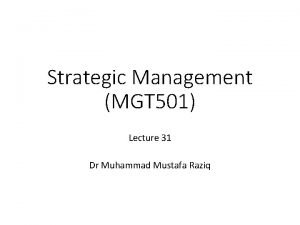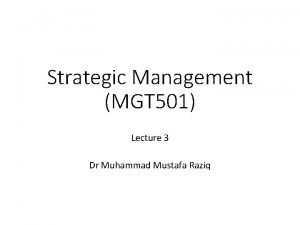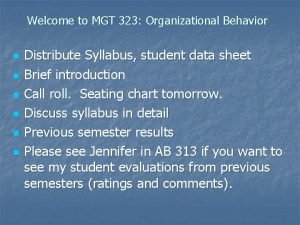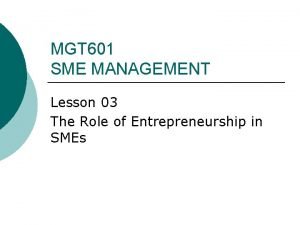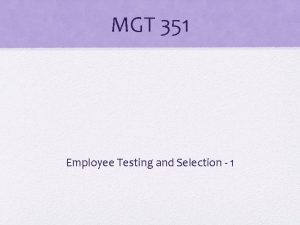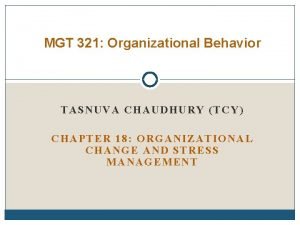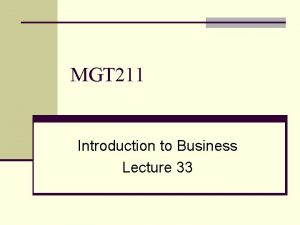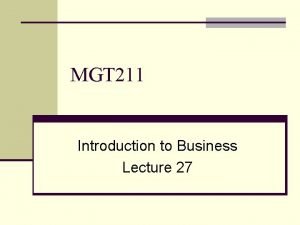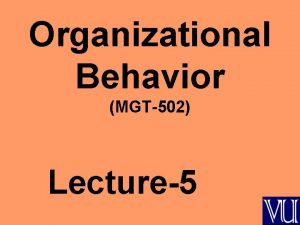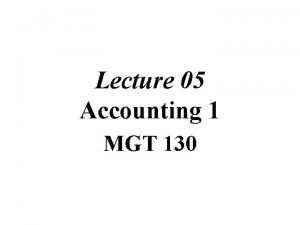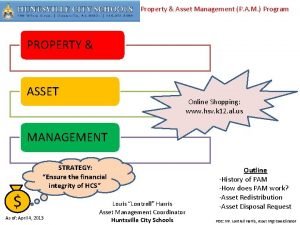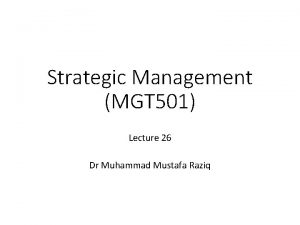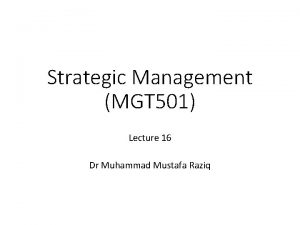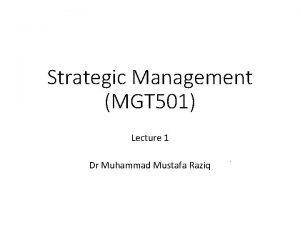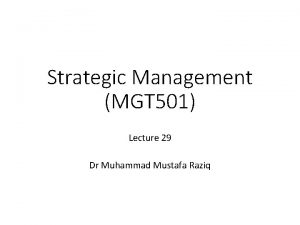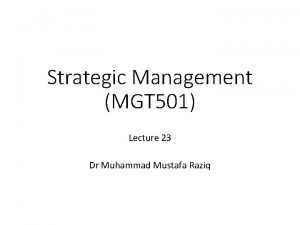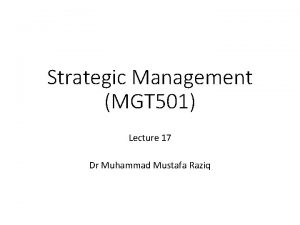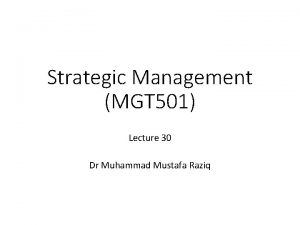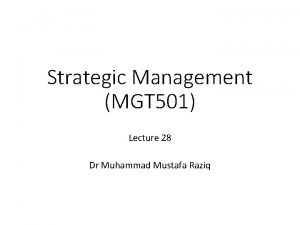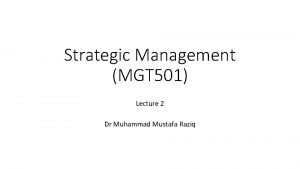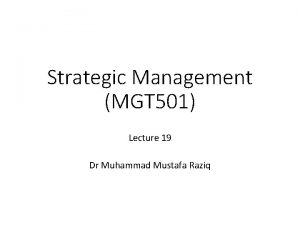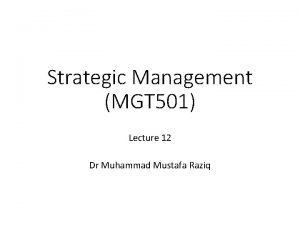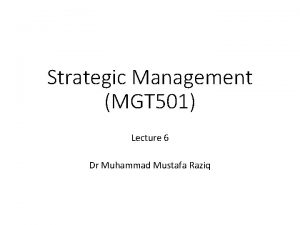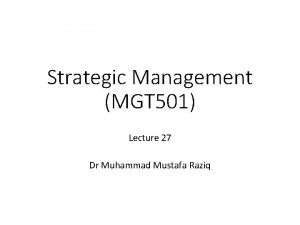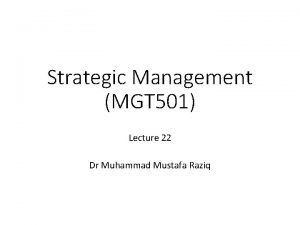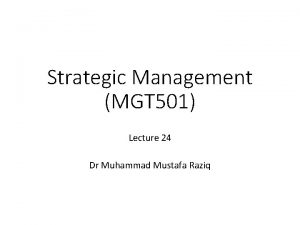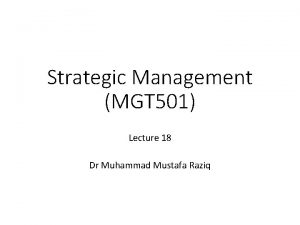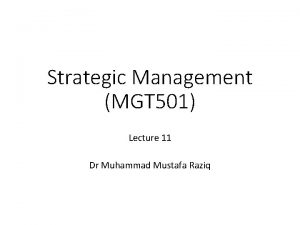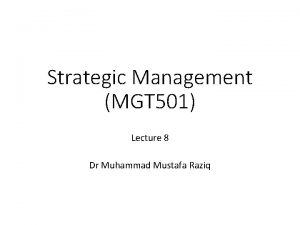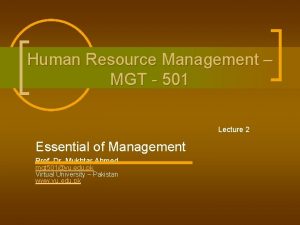Strategic Management MGT 501 Lecture 21 Dr Muhammad
























- Slides: 24

Strategic Management (MGT 501) Lecture 21 Dr Muhammad Mustafa Raziq

Topic Covered in the Previous Lecture • Benchmarking and Industry Standards • Resource-led Strategies • Strategic Advantage Analysis • Open Strategy

Topics to be covered in this lecture • Strategies and Competitive Advantages in Diversified Companies and their Evaluation

Chapter 6: Corporate Level Strategies

Strategies and Competitive Advantages in Diversified Companies and their Evaluation • The different units or businesses of a diversified company have their own business-level strategy based on each unit’s context, managerial skills, risk profiles etc. Resource allocation among different businesses become a key corporate strategy issue • There are frameworks developed to help getting insights into the results of the external and internal analysis. These are Boston Consulting Group (BCG) matrix, GE (General Electric) matrix etc. • Each corporate entity may chose the most appropriate framework from among the available ones or design its own framework to suit its situations and intentions.

6. 1. 1. Corporate Analysis • Corporate analysis is an in-depth evaluation of a corporate entity, its various businesses, and products in order to gain ‘insights’ into the current business portfolio and then ‘imagine’ a business portfolio for the future. • It gives an understanding of the general corporate health, strengths, and the prospects for future growth, through a series of independent evaluations of each aspect of the operations, organizational structure, outputs, finances, and growth opportunities. • Examples: corporate risk analysis, corporate operational analysis, corporate growth analysis • Such provide insights to the internal strategists but also to external investors on growth prospects of the firm.

6. 1. 2. Make, Buy, Ally, or Swap Decision Making • The benefits of internal production in the vertical value chain against costs and risks of using market to buy that particular function or utility, are weighed to determine the structure of the firm and what activities to focus on for inhouse production • Transaction cost economies (TCE) focuses on conditions that lead firms to make rather than buy (Coase, 1937; Williamson, 1985) or to ally (Williamson, 1999) looking at one transaction at a time • TCE explains why a given transaction may be more efficiently governed through either the market or the hierarchy. Thus the boundaries of the firm become permeable and flexible in different ways to interface with customers and suppliers, resulting in different designs of the structure of the firm.

6. 1. 3. Boston Consulting Group Matrix or Growth Matrix • It is a framework developed by BCG, categorizing products within a firm’s portfolio as stars, cash cows, dogs, and question marks according to growth rate, market share, and positive or negative cash flow. • It is based on product life-cycle theory, where cash cows (low growth and high-market share product) are the foundation of a firm.

6. 1. 3. Boston Consulting Group Matrix or Growth Matrix (continued)

6. 1. 3. Boston Consulting Group Matrix or Growth Matrix (continued) • Stars: (Prioritize) investment to strengthen dominant position • Question Marks: ? Decide on divest or through JV/Partnerships try to make it a star (large negative cash flow) • Cash Cows: Milked as long as possible. Supplies funds for investments in other areas; high market share, but competes in low growth industry • Dogs: (liquidate/divest), Strategic Sale

6. 1. 4. GE Mc. Kinsey Matrix or GE Nine -Cell Model or GE Business Screen • It is a corporate strategy framework developed by Mc. Kinsey and Co that gives more importance to market attractiveness when compared to the market growth focus of BCG matrix. • Each SBU (Strategic Business Unit) is assessed on the basis of competitive strength. To apply this tool, the factors that determine market attractiveness and competitive strengths are to be identified for a business in the particular environment in which it wants to operate.

6. 1. 4. GE Mc. Kinsey Matrix or GE Nine -Cell Model or GE Business Screen (continued) • The factors of market attractiveness can be given as follows: • • • Market segments identified and its size Growth of the identified market segment Pricing trends and industry profitability Intensity of competition Overall risk of returns in the industry Product differentiation possibilities Technological requirements Delivery methods Service particulars

6. 1. 4. GE Mc. Kinsey Matrix or GE Nine -Cell Model or GE Business Screen (continued) • Following that, the competitive strength (business strength) is analyzed in terms of competences, brand value, customers’ loyalty, product quantity, market share growth rate, cost structure etc. • Every factor on each of the two dimensions is assigned a weight. The choice of factors and the weights given vary from business unit to unit and involve research • The analysis would give insights into what products to add and which market to focus on. It is also known as directional policy matrix with x-axis of industry attractiveness and y-axis of competitive strength and each product or potential product is mapped as a pie chart

6. 1. 4. GE Mc. Kinsey Matrix or GE Nine -Cell Model or GE Business Screen (continued)

6. 1. 5. IE Matrix (Internal-External Matrix) • It is a framework similar to BCG matrix, but positions various divisions of an organization in a nice-cell display based on two key dimensions: IFE total weighted score on X-axis and EFE total weighted score on Y-axis with low, medium, and high positions (score of 1. 0 to 1. 99 is low; 2. 0 to 2. 99 is medium; and 3. 0 to 4. 0 is strong) • This matrix offers insights whether to grow and build, hold and maintain or harvest and divest the business.

6. 1. 5. IE Matrix (Internal-External Matrix) (continued)

6. 1. 6. Space Matrix (Strategic Position and Action Evaluation Matrix) • It has four dimensions, which in turn comprising several key factors, when compared to BCG or GE or IE matrix. There are two internal dimensions: Financial Strength (FS) and Competitive Advantage (CA); • Furthere are two external factors: Environmental stability (ES) or turbulence and Industry Strength (IS) that together determine the four strategic postures of the firm. • These four strategic postures namely aggressive, competitive, conservative, or defensive can be translated to four generic competitive strategies: that is, cost leadership, differentiation, focus, or defensiveness

6. 1. 6. Space Matrix (Strategic Position and Action Evaluation Matrix) (continued) • The key factors of each of the four dimensions are identified for each firm, assign values between 0 and 6 to each individual factor, and then, plot on a space chart, the averages of each group factor. • The financial strength factors are ROI, leverage, liquidity, working capital, cash flow, etc.

6. 1. 6. Space Matrix (Strategic Position and Action Evaluation Matrix) (continued)

6. 1. 7. Grand Strategy Matrix • It is a tool to evaluate alternative strategies based on two dimensions of a firm: competitive position and market growth with each having two levels giving a four-cell matrix • An organization is placed in any of the four quadrants when evaluated on these two dimensions and then the organization can chose the strategies appropriate for that quadrant.

6. 1. 7. Grand Strategy Matrix (continued)

6. 1. 8. Quantitative Strategic Planning Matrix and Strategic Plan • Quantitative strategic planning matrix is a technique used to determine the relative attractiveness of feasible alternate strategies, integrating relevant external and internal factors. • Weights are given to a list of key external factors and key internal factors and then determine the attractiveness score to alternate strategies conceived intuitively. • Corporate strategic alternatives such as whether to make, buy, ally etc can thus be evaluated.

Summary of the topics covered in this lecture • Strategies and Competitive Advantages in Diversified Companies and their Evaluation

Topics for the next lecture • Diversification and Integration Strategies • Mergers, Acquisitions and Takeover strategies
 Mgt 501
Mgt 501 Mgt 501
Mgt 501 Mgt 501
Mgt 501 Dua e sabah
Dua e sabah At tahiyyatu
At tahiyyatu Strategic management lecture
Strategic management lecture Strategic management and strategic competitiveness
Strategic management and strategic competitiveness Analysing the 6 strategic options megxit
Analysing the 6 strategic options megxit 01:640:244 lecture notes - lecture 15: plat, idah, farad
01:640:244 lecture notes - lecture 15: plat, idah, farad Mgt 323
Mgt 323 Accounting scope
Accounting scope Mgt 601
Mgt 601 Mgt 351 nsu course outline
Mgt 351 nsu course outline Mgt 340 report
Mgt 340 report Mgt 321 chapter 2
Mgt 321 chapter 2 Mgt 211
Mgt 211 Consumer goods are purchased by mgt211
Consumer goods are purchased by mgt211 Mgt 411
Mgt 411 Mgt 385
Mgt 385 Ecv expected commercial value
Ecv expected commercial value Mgt502
Mgt502 Mgt-130
Mgt-130 Financial strategies in retailing
Financial strategies in retailing K12 asset mgt
K12 asset mgt Walter ferrier
Walter ferrier
